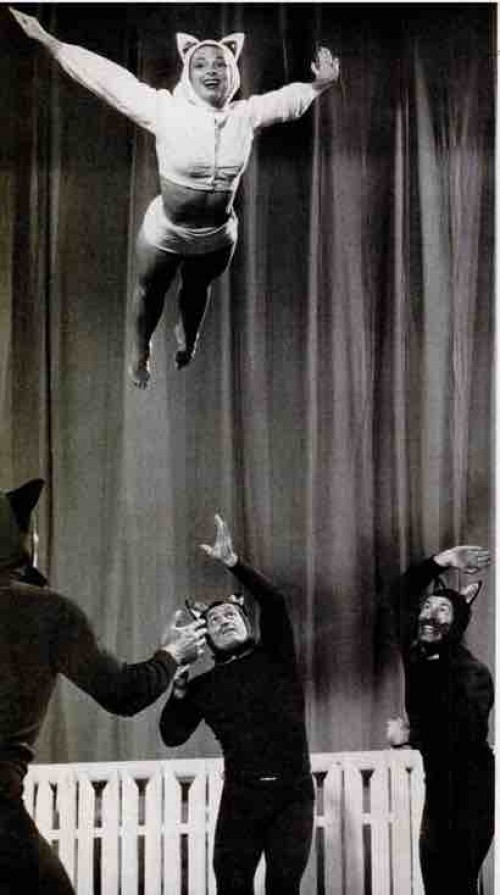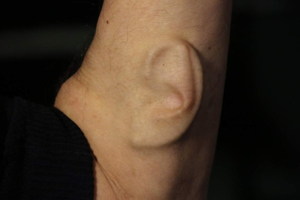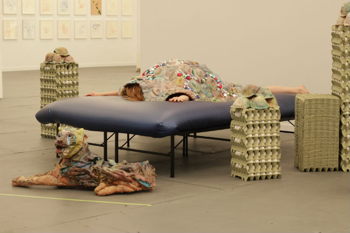Performance Art
I Like America and America Likes Me
In 1974, German artist Joseph Beuys arrived in America for the first time. Upon landing at the airport, he was transported by ambulance directly to the Rene Block Gallery in New York City. He emerged from the ambulance wrapped in a grey felt blanket and was then placed in a room with a wild coyote where he spent the next three days.More in extended >>
Posted By: Alex - Mon Jul 03, 2017 -
Comments (0)
Category: Performance Art, 1970s
Artist Lays Egg

Poincheval hatching eggs
Chuck mentioned a few weeks ago that French performance artist Abraham Poincheval would soon be sitting on a dozen eggs until they hatch. He's now well into the process of doing that and has hatched nine eggs already.
More in extended >>
Posted By: Alex - Sat Apr 22, 2017 -
Comments (0)
Category: Publicity Stunts, Performance Art, Farming, Eggs
Destructivist Art
In September 1966, the first ever "Destruction in Art Symposium" was held in London, highlighting the work of the self-styled Destructivists. Basically, they destroyed things and called it art.LA Times staff writer Robert Toth delivered the following report from the Symposium (LA Times - Sep 11, 1966):
But to justify slaughter of a flock of chickens, more pretentious words are demanded. Said one abortive chicken killer, Ralph Ortiz:
"Destructivist art gives our destructive instinct its essential expression while coming to terms with destruction's most primitive maladaptive aspects — aspects that ordinarily would prove to work for the destruction of the species rather than its survival."
After those words, which seem to mean emotional release for him, the American "artist" looked absurd when the law intervened to prevent the massacre (which, incidentally, was to have bloodied 10 elegantly tuxedoed men as an added attraction).
Ortiz came up with a lone canary but no, not that either, said the RSPCA inspector.
Could he let the bird out the window? No again, for it was a cold night.
The frustrated Ortiz settled for showing a film of a chicken-killing, but not before the coup de grace was administered.
Why not stomp a caterpillar, suggested an onlooker. "I'm not a caterpillar-killer," huffed the affronted artist.
His less ambitious colleagues have fared better. One broke a chair to smithereens. Another created a hole with an ordinary shovel, and promptly priced it at $350.
Ortiz did, however, help axe a piano apart.
In 1996, Raphael Ortiz (he was no longer calling himself Ralph) re-enacted his piano-axing performance at New York's Whitney Museum of American Art... but with one small change. According to NY Times critic Michael Kimmelman, he was now accompanied by "a woman in pigtails and ruffled apron standing on a ladder dropping eggs into a bucket and chanting Humpty Dumpty."

Ralph Ortiz destroying a piano — 1966
Incidentally, literary critic Robert Grossmith has noted that one of the reasons for the obscurity of the Destructivist Art movement is that "not a single Destructivist work of art exists. There are no primary sources. Not a solitary Destructivist novel, poem, play, story, painting, sculpture, film, dance or piece of music was ever produced or, if produced, allowed to survive. In fact if a Destructivist work of art was to turn up today, its very existence would automatically disqualify it from being considered as genuinely Destructivist. There can in short never be a Destructivist work of art, in any accepted sense of the word ‘be’."
Posted By: Alex - Thu Nov 17, 2016 -
Comments (9)
Category: Art, Performance Art, 1960s
A Minute of Dance Per Day
There is just as much of this as you can take--and possibly more than you can take--at her page:More in extended >>
Posted By: Paul - Wed Aug 24, 2016 -
Comments (4)
Category: Avant Garde, Performance Art, Europe
Cabbage Walking
Artists in Kashmir have started walking cabbages (and other vegetables) on a leash, as a way to protest the ongoing military conflict over the region. One artist explains: "What I wanted to do basically is juxtapose the absurdity of this performance with what was happening around—the structures of violence that I was seeing around me."These Kashmir artists cite the Chinese artist Han Bing as inspiration, because he was the first to "walk a cabbage."
This reminds me of how, according to legend, the French poet Gerard de Nerval used to walk his lobster through Paris.

Image source: Shahid Tantray via Vice.com
More in extended >>
Posted By: Alex - Sat Apr 16, 2016 -
Comments (13)
Category: Performance Art, Surrealism
Chicago’s Acro-Theater

Plays that also featured acrobatic & gymnastic stunts. I'm thinking Shakespeare should be performed this way. Hamlet's soliloquy delivered on a trampoline.
More in extended >>
Posted By: Paul - Tue Apr 05, 2016 -
Comments (9)
Category: Entertainment, Exercise and Fitness, Regionalism, Sports, Performance Art, 1940s, 1950s
Man grows ear on arm

He says, "People's reactions range from bemusement to bewilderment to curiosity, but you don't really expect people to understand the art component of all of this."
More in extended >>
Posted By: Alex - Tue Aug 11, 2015 -
Comments (5)
Category: Body, Body Modifications, Performance Art
Inhabited Turtle Shell
For for Frieze art fair in New York, performance artist Kris Lemsalu is lying very still for three-and-a-half hours beneath a giant fake turtle shell decorated with giant rhinestones. And that's it. She calls it an inhabited sculpture.
More in extended >>
Posted By: Alex - Sat May 16, 2015 -
Comments (5)
Category: Art, Performance Art
Guillermo Gómez-Peña
If only I could make it out to Santa Rosa, CA, to see Guillermo Gómez-Peña in his upcoming performance. I am sure my consciousness would be raised to Olympian levels.
Posted By: Paul - Sun May 03, 2015 -
Comments (2)
Category: Annoying Things, Ethnic Groupings, Regionalism, Performance Art
The Living Theatre, Deceased
With the death this month of Judith Malina, the world will be forever deprived of "happenings" like the one in the first clip, where, I regret, Ms. Malina does not appear until the final few seconds.
Posted By: Paul - Sat Apr 18, 2015 -
Comments (1)
Category: Drugs, Avant Garde, Outsider Art, Performance Art, Pop Art, Obituaries, 1970s

| Who We Are |
|---|
| Alex Boese Alex is the creator and curator of the Museum of Hoaxes. He's also the author of various weird, non-fiction, science-themed books such as Elephants on Acid and Psychedelic Apes. Paul Di Filippo Paul has been paid to put weird ideas into fictional form for over thirty years, in his career as a noted science fiction writer. He has recently begun blogging on many curious topics with three fellow writers at The Inferior 4+1. Contact Us |




